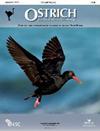Taxonomic revision of francolins – reflections from a central African perspective
IF 1.1
4区 生物学
Q2 ORNITHOLOGY
引用次数: 1
Abstract
Ostrich is co-published by NISC (Pty) Ltd and Informa UK Limited (trading as Taylor & Francis Group) The recent publications by Mandiwana-Neudani et al. (2019a, 2019b) have re-evaluated the relationships of several francolin species, which occur across Africa. They have elevated some forms to full species, but the distribution maps they present are different to those in recently published citizen science projects (Harrison et al. 1997; DowsettLemaire and Dowsett 2006; Dowsett et al. 2008). There does not appear to be a single taxon that is represented by more than one genetic sample, which is well outside the norm for robust studies and does not allow for mistakes in the sample labelling or analysis to be detected (Hunter et al. 2021). Hunter et al. (2021) also commented extensively on their interpretations, mainly from an E African perspective, to which Mandiwana-Neudani et al. (2021) have replied. In this commentary, the focus is on the central Africa forms of Coqui Peliperdix coqui, Chestnut-breasted Pe. dewittei, Shelley’s Scleroptila shelleyi, Whyte’s S. whytei and Red-winged Francolins S. levaillantii and Red-necked Spurfowl Pternistis afer. Specimen data provided by Mandiwana-Neudani et al. (2019a, 2019b) were checked with the online Genbank database and the specimen databases of the American (AMNH) and British Museums of Natural History (BM), respectively. This revealed multiple inconsistencies for these taxa, which are outlined below (Table 1), confirming the concerns raised by Hunter et al. (2021). The lowest denominator of the ‘currency’ of conservation (Frankham et al. 2012) is the type specimen. This is the originally described specimen of the taxon, often taken in a series, where it occurred and how it is phenotypically different to similar forms and are not likely to be available for destructive tissue sampling. To get around this, a topotype (a specimen from the type series or another obtained at the type locality or as close as possible to it) should have been used for the CYTB analyses. Plotting the localities of type specimens sets a baseline, against which the geographical variation of plumage across the current distributional range of the taxa under consideration can be made. Type localities cannot be used to determine the distributions of the various taxa in isolation, but it is reasonable to expect that distribution maps should contain the type locality unless significant habitat change has occurred subsequent to the discovery of the species to preclude this. Mandiwana-Neudani et al. (2019a, 2019b) do not appear to have consulted the type specimens, their descriptions or localities, because their approximate distribution maps do not include the type localities of some taxa. Material from topotypes, with one exception were not sequenced either. This was unexpected, because these baseline specimens should be the starting point for any major taxonomic study. Mandiwana-Neudani et al. (2021) express confidence in their organismal matrix as a taxonomically useful set of attributes, irrespective of the numbers investigated per taxon. The type specimens set this baseline and without reference to these any comparisons are subjective. There is much uncertainty about the morpho-vocalisation scores as a result. Up to 10 specimens were examined initially (Mandiwana-Neudani et al. 2019a, 2019b), but in the response to Hunter et al. (2021) they state that more than 10 specimens of their putative terminal taxa were examined. No specimens of Peliperdix coqui stuhlmanni were located in an online search of databases of the AMNH, BM, Chicago Field Museum and Belgian Museum of African History at Tervuren; all museums with extensive African bird collections and it is uncertain whether more than ten reliably identified specimens of this taxon exist. The defining phenotypic identification criterion used to identify Pe. c. stuhlmanni by Mandiwana-Neudani et al. (2019a) is the reduction in breast patterning, but this is not mentioned in the type description, which states that it is very similar to nominate Pe. coqui (Reichenow 1889). A Coqui Francolin specimen identified as Pe. c. stuhlmanni collected in Malawi in the Zimbabwe Museum of Natural History, shows more breast banding, than Pe. coqui from miombo woodland in Zimbabwe, confirming that the breast patterning of central African male Pe. coqui subspecies can be quite variable (Hall 1963, Irwin 1981) and that it is an unreliable taxonomic character (Irwin 1981). This opinion, from an experienced African field ornithologist and taxonomist, has been overlooked. Mandiwana-Neudani et al. (2019a) incorrectly recorded/nominated Pe. coqui as having an unpatterned breast in their morpho-vocalisation scores (character 8; Table 6) suggesting confusion of the specimens examined and/or errors in the data handling. This confusion extends to the CYTB data, where the sequence of Pe. c. stuhlmanni saved in Genbank (Mandiwana-Neudani et al. 2019a, and their Appendix 2, Genbank FR694152) is registered as Pe. c. coqui (Table 1) with stuhlmanni Perspectivefrancolins的分类修订——来自中非的思考
鸵鸟由NISC (Pty) Ltd和Informa UK Limited(以Taylor & Francis Group的名称进行交易)共同出版。Mandiwana-Neudani等人(2019a, 2019b)最近的出版物重新评估了非洲各地几种弗兰科物种的关系。他们将一些物种提升到完整的物种,但他们呈现的分布图与最近发表的公民科学项目(Harrison et al. 1997;dowsettemire and Dowsett 2006;Dowsett et al. 2008)。似乎没有一个分类单元由多个遗传样本代表,这远远超出了稳健研究的标准,并且不允许在样本标记或分析中发现错误(Hunter et al. 2021)。Hunter等人(2021)也对他们的解释进行了广泛的评论,主要是从东非的角度出发,Mandiwana-Neudani等人(2021)对此做出了回应。在这篇评论中,重点是中非形式的Coqui Peliperdix Coqui,栗子胸Pe。dewittei,雪莱的shelletila,怀特的S. whytei和红翅的富兰克林S. levaillantii和红颈Spurfowl Pternistis后。由Mandiwana-Neudani等人(2019a, 2019b)提供的标本数据分别与在线Genbank数据库和美国(AMNH)和英国自然历史博物馆(BM)的标本数据库进行核对。这揭示了这些分类群的多重不一致性,如下表1所示,证实了Hunter等人(2021)提出的担忧。保护“货币”的最低标准(Frankham et al. 2012)是模式标本。这是该分类单元最初描述的标本,通常是在一系列中采集的,它发生在哪里,它在表型上如何不同于类似的形式,不太可能用于破坏性组织采样。为了解决这个问题,应该在CYTB分析中使用一个拓扑型(从类型系列或在类型地点或尽可能接近它获得的另一个标本)。绘制模式标本的分布图是一个基线,可以根据这个基线来确定所考虑的分类群在当前分布范围内的羽毛地理变化。模式位置不能单独用于确定不同分类群的分布,但合理的期望分布图应该包含模式位置,除非在物种发现之后发生了重大的栖息地变化,以排除这种情况。Mandiwana-Neudani等人(2019a, 2019b)似乎没有参考模式标本、它们的描述或位置,因为他们的近似分布图没有包括一些分类群的模式位置。除了一个例外,来自拓扑型的材料也没有被测序。这是出乎意料的,因为这些基线标本应该是任何主要分类学研究的起点。Mandiwana-Neudani等人(2021)表示相信他们的有机体矩阵是分类上有用的属性集,而不管每个分类单元调查的数量如何。模式标本设定了这个基线,没有参考这些,任何比较都是主观的。因此,关于形态发声得分有很多不确定性。最初最多检查了10个标本(Mandiwana-Neudani et al. 2019a, 2019b),但在对Hunter et al.(2021)的回应中,他们表示对其假定的终端分类群的10多个标本进行了检查。在美国国家博物馆、大英博物馆、芝加哥菲尔德博物馆和比利时特乌伦非洲历史博物馆的数据库中,在线搜索没有找到Peliperdix coqui stuhlmanni的标本;所有拥有大量非洲鸟类收藏的博物馆,也不确定是否存在超过10个可靠鉴定的该分类单元标本。定义表型鉴定标准用于鉴定Pe。Mandiwana-Neudani等人(2019a)的c. stuhlmanni是乳房图案的减少,但在类型描述中没有提到这一点,它指出它与提名Pe非常相似。coqui(赖希诺1889)。科奇·弗兰克林标本,鉴定为Pe。在津巴布韦自然历史博物馆收藏于马拉维的c. stuhlmanni,比Pe。在津巴布韦的miombo林地中发现了coqui,证实了中非男性Pe。coqui亚种可以是相当可变的(Hall 1963, Irwin 1981),这是一个不可靠的分类特征(Irwin 1981)。这一观点来自一位经验丰富的非洲野外鸟类学家和分类学家,却被忽视了。Mandiwana-Neudani等人(2019a)错误记录/提名Pe。Coqui在他们的形态发声评分中有一个没有图案的乳房(8字;表6)表明所检查的标本混淆和/或数据处理错误。这种混淆扩展到CYTB数据,其中Pe。Genbank中保存的c. stuhlmanni (Mandiwana-Neudani et al.)。 2019a,及其附录2 Genbank FR694152)注册为Pe。c. coqui(表1)与stuhlmanni视角
本文章由计算机程序翻译,如有差异,请以英文原文为准。
求助全文
约1分钟内获得全文
求助全文
来源期刊

Ostrich
生物-鸟类学
CiteScore
2.10
自引率
30.00%
发文量
24
审稿时长
>12 weeks
期刊介绍:
Ostrich: Journal of African Ornithology is the leading ornithological journal in Africa, and publishes peer-reviewed scientific papers and short communications (
 求助内容:
求助内容: 应助结果提醒方式:
应助结果提醒方式:


